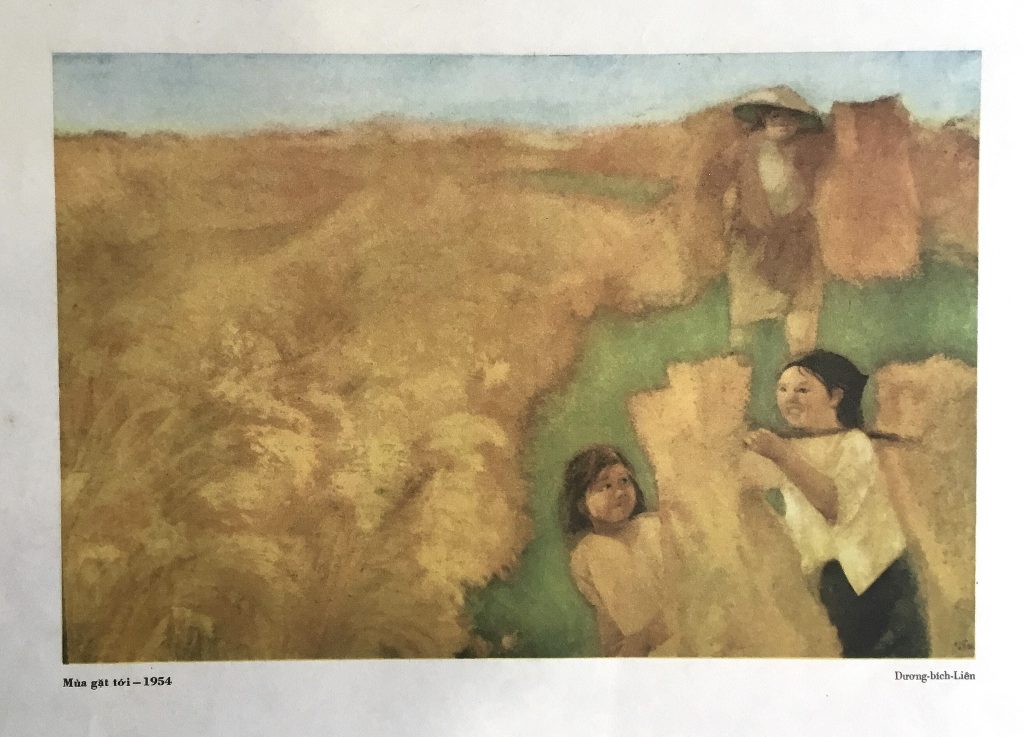(From a research perspective)
In a document, artist Nguyễn Văn Tỵ (1917-1992) wrote: “Annotating paintings is an important historical issue – we need to be scientific in studying time and environment to avoid getting lost for future generations.” He gave an example:
- The woodcut painting ‘Two Mường ladies go to the festival’ was made in 1938-1939 during the trip to paint Bờ market – Rút stream… Yet the collection of woodcuts by the Culture Publishing House noted that the year was 1943…
- This color woodblock painting was first displayed at the 1939 SADEAI Exhibition at Chambre de Commerce on Francis Garnier Street, today it is Đinh Tiên Hoàng International Post Office. In 1939, Nguyễn Đỗ Cung became Chairman of SADEAI, the first time this position was regained in Vietnamese hands after the conflict with Jonchère from France since 1938.
- As well as Nguyễn Đỗ Cung’s first field trip, in October 1946, after the Exhibition commemorating the first anniversary of the August Revolution and the National Day on September 2, the trip included Đỗ Cung and Văn Giáo. On the literary side, there were Tô Hoài, Xuân Diệu, Nguyên Hồng, Nguyễn Đình Lạp, Nguyễn Tuân, Sỹ Ngọc, Nguyễn Văn Tỵ… Yet Văn Nghệ Newspaper changed the date to 1947 in two articles about Đỗ Cung, after he passed away.
(Excerpt from the diary of artist Nguyễn Văn Tỵ, February 12, 1979)
Just a few notes by artist Nguyễn Văn Tỵ show the importance of “annotating the work”. Because accurate annotations about the work’s descriptions such as date, medium, dimensions… will give researchers and future generations an objective, complete, and fair assessment of the work typical in an artist’s career.
Each artist will have periods of creation with different themes. But with “shaping style”, it is not really like that. An artist’s personality and style are sometimes formed from a very young age. That style even followed the artist until the end of the career – as a signal to recognize the “creative personality” in the work. But there are also artists who have completely changed both the visual perspective as well as the subject matter. This sometimes causes mixed opinions about authenticity when discussing a work, especially works by famous artists.
When mentioning the name Nguyễn Sáng (1923-1988), art lovers will imagine the ‘Party admission at Điện Biên Phủ’, ‘Citadel for the Fatherland’, ‘Universe’, ‘Object’ or coherent, strong portraits… then “accepting” a “different or even not special” image of Nguyễn Sáng at the time he was still studying had to rely on text documents, photo documents and annotations in details.
Annotations play an important role in deciphering an artwork, thereby placing the correct role and position of the work in the artist’s career as well as the fine arts of the nation.
Painter Nguyễn Đỗ Cung (1912-1977) had the greatest contribution in building and developing Việt Nam Fine Arts Museum and the Institute of Fine Arts. In 1937, he saw in person the artifacts at Phật Tích Pagoda (Bắc Ninh) during an archaeological excavation to restore the upper area. He realized that the “characteristic nationality” of ancient Vietnamese art is different from the culture from the North.
In fact, Nguyễn Đỗ Cung was an artist who always searched for Western art trends of the early twentieth century with the desire to create new nuances for painting. Like other artists, he studied at a French school with French teachers and absorbed the essence of Western civilization, but his national blood was always strongly present.
In 1937, when Principal Victor Tardieu (1870-1937) passed away, Sculptor Évariste Jonchère (1892-1956) took over as the new Principal of the Indochina Fine Arts College in 1938, declaring: “The good of Indochina is a distinctly skillful one. So we shouldn’t wait for them to have works of inspiration… I went to Hanoi this trip just to train fine artisans, not artists”… Immediately, artist Nguyễn Đỗ Cung had some direct ideas frankly with the above idea when inviting Jonchère to see “the sculptures at Dâu pagoda, Đình Bảng communal house, Cói pagoda, Keo pagoda, or Chu Quyến communal house…” to clearly see the unique national character of Vietnamese cultures.
And to answer the comments from Principal Jonchère or scholar Bezacier that Vietnamese people are “only skillful”, the work ‘The gate of Huế imperial city’ of Nguyễn Đỗ Cung painted in 1941 is a testament to “creativity based on the Cubist style with a theme that is both historical and national.”
Therefore, just one modest work, ‘The gate of Huế imperial city’ by Nguyễn Đỗ Cung since its creation (in 1941) has always been a landmark “keyword” in his national ideology.
For artists in general and painters in particular, when their works in addition to expressing “creative personality, personal identity” and artistic achievements, the theme in the composition is very important. This determines the “ideological level and nationality” of the artist’s ideology. Great works are historical, social, cultural… along with unique visual style that have lasting vitality over years.

The work “Yong women of Tonkin sewing” of Nguyễn Văn Sáng (Nguyễn Sáng, 1923-1988) printed in
the catalogue of 1943 exhibition in Japan. The work was in the students’ display area.

The woodblock print “Two Mường ladies go to festival” of Nguyễn Văn Tỵ (1917-1992),
was created in 1939 correctly.

Nguyễn Văn Tỵ drew Nguyên Hồng’s portrait in the trip
(include Nguyễn Đỗ Cung) in 1946 (December 23), then documents about
Nguyễn Đỗ Cung written that the year was 1947.

Nguyễn Đỗ Cung (1912-1977) paint “The gate of Huế imperial city” in 1941 after frankly discussing
about national cultural perspectives with French teacher and scholar.

Bùi Xuân Phái made the portrait of Mr Nguyễn Văn Lâm (Lâm cafe) in 1964.
We could see the work “The gate of Huế imperial city” of Nguyễn Đỗ Cung in this work
(At that time “The gate of Huế imperial city” belonged to the collection of Mr Nguyễn Văn Lâm).
Written by Viet Art View
Copyrights belong to Viet Art View







